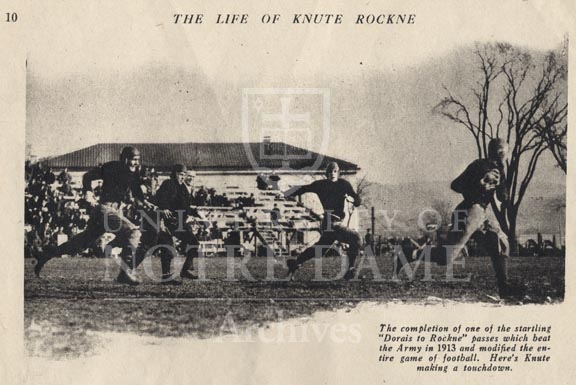
Notre Dame’s relationship with the military also extends to the athletic fields. Many Notre Dame traditions and myths were born out of football games with Army. In 1912, newly appointed Athletic Director Jesse Harper contacted West Point about arranging a football game for the 1913 season, which began a long and fierce rivalry.

While Notre Dame was certainly the underdog, her team was far from untalented and struggling. Notre Dame had already begun to make a name for herself on the football field with players like Louis “Red” Salmon (1903 third-team All American) and the 1909 Western Champions. From 1906-1913, Notre Dame lost only three games, tied five, and won fifty-one. The 1913 season would give Notre Dame an opportunity to showcase her talent outside of the Midwest, with formidable opponents such as Army, Penn State, and Texas.

Notre Dame took Army off-guard with plays using the newly-developed forward pass. While this technique had been used in other games by other schools, Quarterback Gus Dorais and Knute Rockne often receive credit for its invention because of this high-profile opponent.

Caption: “The completion of one of the startling ‘[Gus] Dorais to Rockne’ passes which beat the Army in 1913 and modified the entire game of football. Here’s Knute making a touchdown.”
After the 1924 Army game, sports writer Grantland Rice forever changed the name of Don Miller, Harry Stuhldreher, Jim Crowley, and Elmer Layden to “The Four Horsemen.”

Student George Strickler, who worked as a press assistant for the Athletic Department, actually had put the bug about the nickname of the Four Horsemen into Grant’s ear in the press box. After the game, Strickler arranged to have these four players photograph taken on top of actual horses, thus producing one of the most widely recognized photographs in sports history.

Don Miller, Elmer Layden, Jim Crowley, and Harry Stuhldreher, 1924
Much lore surrounds the 1928 Army game when Coach Knute Rockne took a losing team into the locker room at halftime and gave a rousing speech, summoning the memory of George Gipp, which turned the tide for Notre Dame. No one really knows what was said in that locker room or between Gipp and Rockne in 1920, but Rockne later published his “Win One for the Gipper” speech in Collier’s magazine. Over the years it became ingrained in American culture, strengthened by its presence in the media, particularly Ronald Reagan’s portrayal of George Gipp in the 1940 movie Knute Rockne All American.

After 1947, Notre Dame and Army met less often on the football field, only a handful of times per decade. Saturday November 20, 2010, the two teams will meet again in Yankee Stadium, which was the venue for this rivalry every year from 1925-1946, with the exception of playing at Soldier Field in 1930.
Sources:
2010 Football Media Guide compiled by the Athletic Department (History & Records – Part 3)
Shake down the Thunder by Murray Sperber
UADR 3/21
GSBH 1/08
PATH 3-03-Bi-Tr-p10
Dome yearbook 1925
GBBY 45F/944
GBBY OVF/245

Football is independent, but most other varsity sports are currently in the Big East (hockey is part of the CCHA). Notre Dame will join the ACC in the next year or so, but football will remain relatively independent (ND will have to play a certain amount of games versus ACC schools).
It’s a long story of why Notre Dame is independent. Notre Dame tried to join the Big Ten many times, but was locked out, seemingly because of bad blood with Michigan’s Fielding Yost and general anti-Catholic sentiment. That experience put a bad taste Notre Dame’s mouth and it wasn’t going to loose its Catholic identity to a conference. That stubbornness still exists today among fans and alumni since Notre Dame proved that it could dominate the national football scene without being locked into a regional conference for much of the 20th century.
I would suggest reading the following books and articles:
Notre Dame Magazine, “In a League of Its Own” (http://magazine.nd.edu/news/31344-in-a-league-of-its-own/)
“Shake Down the Thunder,” by Murray Sperber (http://books.google.com/books?id=lXGEcVjBET0C&printsec=frontcover&dq=shake+down+the+thunder&hl=en&src=bmrr&ei=ba13TsmcBezH0AGKvMymDQ&sa=X&oi=book_result&ct=result&resnum=1&ved=0CC0Q6AEwAA#v=onepage&q&f=false)
“Natural Enemies,” by John Kryk (http://books.google.com/books?id=ISKvtzizxscC&printsec=frontcover&dq=%22natural+enemies%22+michigan+%22notre+dame%22&hl=en&sa=X&ei=n78wUaLqLrHv0QG_04DIBQ&ved=0CDMQ6AEwAA#v=onepage&q=%22natural%20enemies%22%20michigan%20%22notre%20dame%22&f=false)
Army, Navy, and Notre Dame are Independents. I understand Army and Navy, but why Notre Dame? I believe the basketball team is in the big east may be wrong though.
Thanks for such informative and helpful article ND vs. Army.